Product Requirements:
Device:
Palm III series, All Handspring Visors,
Hewlett-Packard Jornada 520 & 540 series, iPAQ 3100 & 3600 series, Casio
E-100 series, Casio E-500
Minor updates added 05/23/01, in RED
Even more updates added 06/28/0, in GREEN
In that never ending quest for screen protection, I have found a product that
is a bit different than what I am used to. Instead of being a precut, stick-on
screen cover, PDA Screen Protectors
are a thin piece of film that slides under the edges of plastic or metal
that surround the
screen of your PDA. These screen protectors are 2.76" (70.16mm) wide x 3.27" (83.03mm)
tall.
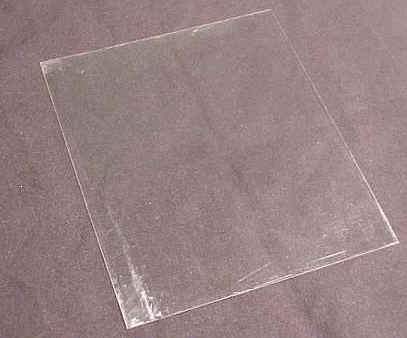
(Be aware that this unflattering picture was taken after I
removed the screen protector from one of my test PDAs. When you first get them –
they are completely unblemished.)
I am a firm believer in "protection", and I have the old
carcasses of past PDAs to prove that scratches can happen to even the most
careful of people.
In recent years, I have even gone without using my PDA until I could get a
screen cover on it. That is how phobic I am of scratches. You can laugh all you
want, I realize that I am being a bit neurotic. :0)
I was interested when I first heard about this product – especially the fact that
PDA Screen Protectors claim that they can work on all of the PDA’s pictured on
their web page. I have listed those units at the top of my review. The
price also sounded pretty good to me, too.
For someone like me, the idea of being able to buy just one screen protector
that will work on just about all of my PDAs holds quite a bit of appeal, as I
currently have in my possession a Palm IIIc, a Palm m100, a Hewlett Packard
Jornada 548, a Handspring Visor Deluxe, a Cassiopeia EM-500, a Palm m500, and a
Compaq iPAQ.
Considering how varied the screen areas of the PDAs they claim they’ll fit
are, I thought it would be interesting to give the protectors a try on all of
the PDAs I currently have.
The directions that come with the PDA Screen Protectors appear rather simple.
Since you are inserting an object that is larger than the screen area of your
PDA, there is a bit of sliding and slipping required to position them correctly.
Needless to say: Fingerprints and dust are the enemy here, and you will want to
start with a properly cleaned screen.
They recommend washing your hands before beginning, and then using the
included cloth to wipe the screen down – using your "huffed" breath as
a cleaner. I said breath guys, not spit….don’t get excited! ;0)
You are supposed to buff your screen till all fingerprints and smudges
are gone. Then you will blow on the screen to make sure that all the linty
"floaters" are gone.
You are now ready to apply protection…
Following the directions in the enclosed how-to diagrams, you will slide and
squeeze the PDA Screen Protector until it is installed properly over your
screen, and under the plastic or metal sides of your PDA as the case may be.
Since my iPAQ is my everyday PDA, that is the one I started experimenting
with. I will tell you right now that there was much cussing going on from desk
today. I wasted no less than 4 of the dozen protectors I was sent, either by
bending corners, or by smudging the protectors beyond belief. I was getting very
frustrated to say the least. You need to realize that I am neither a
contortionist, nor am I someone that thinks it is worth killing yourself to save
a buck or two. I decided to try installing on the iPAQ again a bit later, after
I had had some time to cool down.
Determined not to give up, as I know there are other PDAs with larger screen
surfaces, I decided to give the protector a try on the Cassiopeia EM-500 that
Julie is loaning me. In a couple of seconds, I had the protector installed, and
it was beautiful! Although I managed to get some smudges on the surface of the
protector, when the EM-500 was turned on, I really couldn’t see them anymore. I
tried writing on the screen cover, and was pleased at the smooth glassy feel of
the writing surface. My stylus was writing on it beautifully. After this review
is completed, I will be leaving this screen protector installed. I like it that
much.
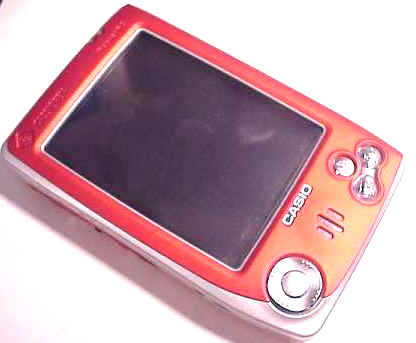
Next, I tried the Handspring Visor. I could not get the edge of the Screen
Protector to go under the plastic sides next to the screen at first (as the
sides fit so tightly), but I was eventually able to weasel the protector under
every edge. It took a little work, but it was do-able. When I turned on the
Handspring, I noticed that on the monochrome screen there seemed to be some
glare due to the glossy screen cover, but certainly not an ungodly amount.
That’s when I ran into trouble… All of a sudden, I realized that none of my
hot-buttons were working anymore, nor was the screen responding to any of my
taps! I reset the Visor, and the same problem persisted. The minute I pulled the
PDA Screen Protector off my PDA, the Visor quickly ran through the sequence of
the buttons I had just tried pushing. Needless to say, that freaked me out!
After a bit of playing around with the protector, the buttons began to work
properly, and the screen also began to respond. Why this happened, I don’t
know…your guess is as good as mine.
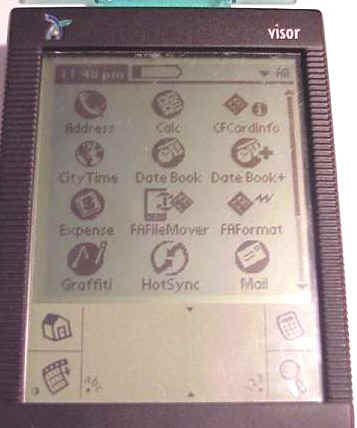
Next up was the Palm IIIc. I was easily able to install the Screen Protector
on this PDA, and all buttons and screen taps worked properly after installation.
I think I may just leave the protector on the IIIc, as it looks nice when the
unit is turned on.
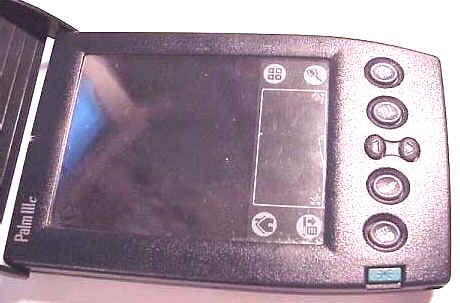
I already knew not to bother with the Palm m500 or the M100, as neither is a
supported PDA. That brought me back to the iPAQ. Since I don’t like being unable
to do anything when it is supposed to be possible, I knew that one way or
another, I was going to get that protector on the screen of my 3670!
Well, you would think that since I had been able to install the protectors on
all those other PDAs, that I would be able to get it right with the iPAQ.
Unfortunately, I was right back at square one. My husband was kind enough to
give it a try – and he was successful! Only problem was, that like the
Handspring Visor, the screen and hot buttons would no longer respond for me at
all – even after a soft reset! I played with the protector some – sliding it
upwards a bit, and all of a sudden – like the Visor – it began to work! I have
no idea what the problem was, but it is now working. I was unable to install it
by myself, though – so that is still quite frustrating!
05/23/01 – John Salazar, with PDA Screen Protectors,
has informed me that due to overwhelming demand they will be making an iPAQ
specific screen protector. I think that’s a great idea, as the glossy feel of
the protector is very similar to the feel of writing on the naked iPAQ screen.
You shouldn’t have any trouble applying these to your iPAQ, once they are sized
for easy install.
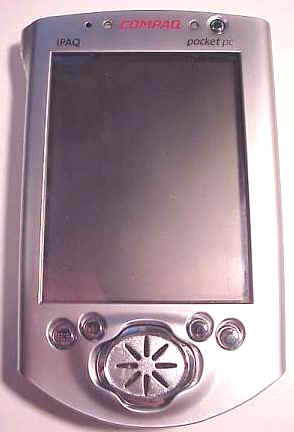
Last, I tried the Hewlett Packard Jornada 548. Now, as most of you probably
know, the Jornada has a slightly smaller screen than the other Pocket PCs. I
knew going in that it would be tough to install this huge piece of plastic – but
I figured I would give it a try. Well, I was unsuccessful, to say the least. My
husband saved the day again, and with much crackling and creaking was able to
manipulate the Screen Protector under the sides. I guess that on this particular
screen, you must be somewhat of a persistent contortionist to have
success.
05/23/01 – I have received screen protectors cut
specifically for the HP 54x. These are easy to apply, and need no cutting down
nor contortions to apply. :0) Simply make sure you mention the PDA you are
purchasing for when you order.

06/28/01 – A specially cut screen protector size has
been added for the Kyocera smartphone! This is an excellent item to use, as the
flip-lid on the phone does not protect the entire screen when closed.
I had cut one of the HP 548 protectors to fit my phone,
and when I mentioned it to John he told me he was going to make that size
available! As you can see here, I have the Fitaly
Stamp on my Kyocera, with the screen protector laying over it. This
combination works perfectly.

Once PDA Screen Protectors are actually on the screen of your PDA, they do
provide a glossy, glass-like surface that is a pleasure to write on. I am not
going to make any claims about improved handwriting recognition, but I did like
the feel of using the protectors.
One thing that I did not like, was that fingerprints and smudges seem to look
10x worse on these than on other screen protection that I have tried. Of course,
that is when the PDA is turned off. Once the PDA is on, the screen protectors
really don’t do anything that would detract from the screen, and I think that
they are a good product.
My one concern might be that if in the installation process you managed to
get a bit of dust or other "funk" under the plastic film, it could
definitely rattle around all over your screen, causing scratches. You will just
have to be very conscientious and careful when installing.
So what’s my verdict?
As far as the iPAQ, Handspring Visor and the HP 548…if you don’t have a
nervous breakdown installing them and if they don’t somehow negate
your screen or hot-buttons, then you should like them just fine.
In the case of the Palm IIIc, and definitely the Cassiopeia EM-500, I think that
they are a great screen protector, and a good value for the money.
Price: $9.95 for 12, $14.95 for 24, $19.95 for 36,
$24.95 for 48, and $34.95 for 72
Pros:
Inexpensive
Glossy, glass-like feel – easy to write on
Fits a wide variety of PDAs
Do not detract from vision of screen
At this price, you can replace often and as needed
05/23/01 Special sizes are now available for the HP 548
and Compaq IPAQ – be sure to specify when ordering
06/28/01 Special size also added to fit the Kyocera
Smartphone
For those interested: These are my favorite screen protection :0)
Cons:
Smudges and fingerprints are very visible when PDA is off
3 Universal 5" Screen Protectors for Digital Cameras, Camcorders and Cell Phones. For Pentax, Nikon, Sony, JVC, Panasonic, Canon, Fuji, Olympus, LG, HTC, Apple, iPhone, Samsung, Nexus + Microfiber Cloth
$7.69 (as of December 12, 2025 19:24 GMT -05:00 - More infoProduct prices and availability are accurate as of the date/time indicated and are subject to change. Any price and availability information displayed on [relevant Amazon Site(s), as applicable] at the time of purchase will apply to the purchase of this product.)i-Tensodo 2 Pack Universal Trimmable Matte Screen Protector for All Smart Navigation, Anti-Glare Anti Finger Print, Sizes: 8.07 x 7.08 inches
$7.80 (as of December 12, 2025 19:24 GMT -05:00 - More infoProduct prices and availability are accurate as of the date/time indicated and are subject to change. Any price and availability information displayed on [relevant Amazon Site(s), as applicable] at the time of purchase will apply to the purchase of this product.)Product Information
| Price: | 9.95 |
| Manufacturer: | PDA Screen Protectors |
| Pros: |
|
| Cons: |
|



Gadgeteer Comment Policy - Please read before commenting
Post your comments here on the Sprint PCS Toshiba 2032SP Pocket PC.
http://www.the-gadgeteer.com/toshiba-2032sp-ppc-review.html
Just click the POST REPLY button on this page.
Good review, I’ve got one more question about the usability of this device :
You say that you don’t like the way it handles voice calls (speaker mode etc) and that you would still like to carry a normal small PCS phone. So wouldn’t it be better to carry around a bluetooth enabled PocketPC and a bluetooth phone ? This way you have wireless capabilities on your PocketPC (email, browsing, msn) and still have a small phone for voice calls…seems like a better trade off to me.
What are your thoughts on this ?
Kind regards,
Ivan
denivan,
I agree that a BT enabled phone and PDA might be the way to go for some – but where I live, there are no BT enabled phones available by any of the major carriers – so I don’t even have that option. 🙁
A PDA/phone like this is actually the best solution for me when I want a wireless PDA that can connect virtually anywhere (and make occasional voice calls).
You can, of course, use the wired earbud headset with this PDA when you want it to be in phone mode. Using the headset would make voice calls much more convenient from the PDA.
Unfortunately, I have never been big on headsets…that’s the main reason I would keep a separate phone. The cool thing is tht Sprint PCS allows you to add a phone to your current plan for $20/month, so this is a viable option.
Judie :0)
Okay, I’ve got another question 😉 Being european, I don’t really know what technology your carrier (PCS) uses…how fast is the download speed, can you do some tests maybe ?
In europe we can only use GSM (which imo is pretty handy, using the SIM card and all) , the high speed data equivalent for GSM is GPRS and works pretty well for me, it’s not blistering fast, but it’s about the same speed as a normal 33.6 or 56 K modem.
Pretty weird though that your phone operators don’t have any phones with Bluetooth built in, I thought almost all new phones had it. Over a year ago, the only phone with BT was my SonyEricsson T68i (which I’m still happily using), but nowadays almost all new phones (except budget phones) seem to have Bluetooth. Does PCS use propietary phones or something ? I don’t quite understand why any phone manufacturer would make a phone these days withouth Bluetooth in it. Maybe all you people should start mailing PCS about how us europeans are passing you by on the technology front :p
Kind regards,
Ivan
Ivan,
The fact that you are in Europe explains alot, regarding your advanced GSM/GPRS/BT etc status. 😉
I live in San Angelo, TX – population >100K. We are landlocked with no interstates, basically surrounded by desert on one side and rolling hills on the other. The only carriers we have are Cellular One and Sprint PCS. Cellular One isn’t really a contender – they offer some digital services, but they are predominantyly analog – which is actually pretty good for the rural customers as they have a massive tower framework in place.
Sprint PCS is the “digital alternative,” but if you take a look at the phones they offer – you will see that there are no BT models, and that they use CDMA instead of GSM/GPRS.
Of course, people that live in larger US cities do have access to these services through other carriers such as T-Mobile, Verizon, AT&T, etc., but where I live…”it ain’t happenin’,” and we are happy to at least have what we have got.
Hopefully, one day, the US will have the same unified wireless infrastructure that Europe enjoys…but until then, we will have different carriers on different type networks, offering different phones, offering differnent…
Judie :0/
Cool, seems logical though that huge parts of the US still use analog or cdma, because of its large areas. Where I live (Belgium) mobile coverage is about 99% of the country, for all three mobile service providers, that’s the benefit of living in a country that’s about the same size as George Bush’s home ranch :p
Final question (sorry, but I’m curious ;)) Are all those technologies interoperable : can someone with an analog phone call someone with digital cdma or gsm ? And what about text messaging ? Is that used much in the US and does it work accross different operators ?
Thanks in advance for answering my many questions, it’s kinda fun to see the differences between US and Europe on the technological front.
Ivan
Ok, to the best of my knowledge, here is how it works…
There are different types of coverage: Digital and Analog. Analog covers more of the US and definitely more of the rural areas, Digital is in more urban areas, but in some rural ones as well.
There are phones that can only handle digital networks (Single band – like the Sanyo that I use). The simply don’t get a signal when you are in a non-digital area. Then there are phones that get both Analog and Digital (Dual band, like my husband’s Sanyo) These work in the digital areas, but will probably be “roaming” when you enter an analog area – but at least you have the option of making calls. The downside is that when in analog mode, battery life is greatly reduced, and you can’t access any of the digital features of the phone – just straight up voice calls. That means in analog you can’t get text messages, access your e-mail, etc.
You can call any number with any wireless phone – be it digital, analog, or land line – and a call will be placed.
Depending on your phone calling plan, you can call any phone, anywhere in the country without it being a long distance call.
Any questions? 😉
Judie :0)
Judie, a couple of comments on your very nicely-written review, as well as Ivan’s questions.
1. Note that the Toshiba 2032SP is not a Pocket PC Phone Edition, but rather a Pocket PC with proprietary phone software bolted on top. As such, it’s lousy for phone features, as you note. “Real” Pocket PC Phones, like the T-Mobile Pocket PC Phone Edition and the upcoming Samsung i700 for Verizon/Sprint, have much better battery life and are much more comfortable to use as a phone. I have a Pocket PC Phone Edition and it has easily supplanted my need for two devices, although I’d still like Bluetooth. The 2032 is also outdated technology, based on the 570.
2. Ivan/Judie, CDMA is a digital air standard, similar to the TDMA standard used for GSM. CDMA happens to be more spectrally efficient and can support higher data-rates, so everyone in the world (including both current GSM and IS-95 CDMA operators) are moving to next-generation CDMA-based implementations, long-term. Unfortunately, they’re not all moving to the same implementation — Sprint/Verizon, here, are moving to cdma2000 by Qualcomm (of which 1xRTT is the first step), as opposed to GSM’s wCDMA/UMTS specification. Check out this long post of mine on Pocket PC Thoughts which explains the situation in a bit more detail.
2a. BTW, PCS isn’t a technology. It merely specifies the 1900MHz frequency band. Sprint PCS currently uses 1xRTT cdma2000 as its underlying communications technology.
3. As for Bluetooth, it has nothing to do with the digital standard per se, but rather the way carriers operate in the US. Verizon and Sprint, in particular, are loath to release Bluetooth phones because they are afraid it’ll mess with their cost models. The phone market isn’t as open here due to things like aggressive carrier-locking, so we don’t get the open competition that happens in many European countries. Currently, the only way to get a high-speed Bluetooth phone in the US is to go GSM, for which a number of BT phones are available, as you note. This may be changing, as SE is rumored to be releasing a BT phone for Sprint (the T608). We can only hope. 🙂
–janak
Thanks for the comments Janek!
Judie :0)
Judie:
Great review. Any thoughts on how the 2032 comapres to the Treo 300 as a PDA/Cellphone combo?
Also, have you been keeping an eye on the Samsung developments? I know these are all in the Palm camp, but I found the Samsung i300 to be much more phone like (smaller and lighter) than 2032, and the soon to be released i500 clamshell (same size as the Samsung 8500 and Sanyo 8100 series), may be heaven sent. Both are dual band/trimode – so you can analog roam (a necessity out here in West Texas), but better still they are both “phone-centric”
Obviously screen quality & size won’t match the 2032, but I think having serious PIM software in a real cell phone body will be a big attraction to many users.
How come I can’t receive Text messages? It gives me a link and says “select go” to read it. it is telling me to go to the sprint website and login, but I just want to be able to send/receive SMS from my phone! why is this so difficult?
Judie,
Thought you should know that I was using a Bluetooth phone from T-Mobile in San Angelo before I relocated to North Dakota. Although T-Mobile didn’t have an office there, they had data coverage there as well as in Midland, Odessa, Abilene, Lubbock and the larger cities.
Ironically, I now find myself in a place where T-Mobile does not have coverage and have purchased a Thera. It’s a good alternative. I don’t even spring for broadband and spend most of my time on-line with it when my minutes are free.
Still, once in a while, I’ll use it to FTP photos, look up an address or check the weather forecast or my email.
I agree that it’s a klunky phone, but it’s a great PDA and I’d rather worry about keeping one battery-sucking device fed than two less-demanding gadgets charged.
You can find very inexpensive AA battery packs on Ebay for the Thera. Just search “Maestro”. It’s a compatible model by Toshiba, and, no, I’m not selling them.
I’d never buy a phone edition model because I can use this phone to edit mileage spreadsheets AND play mp3s. How cool is that? 🙂
I’m glad to hear you’re working out well with your Thera, but just a small point of clarification: Phone Edition isn’t the same thing as a Smartphone. Phone Edition devices are similar to the Thera (touch screen, full Pocket PC functionality), but they’re running MS’s standardized Pocket PC Phone Edition software, with a standardized dialer/contacts/etc. interface. Plus, they generally have better battery life. I’ve listened to MP3s and worked with Excel sheets many times over the years. 😉
Smartphones, on the other hand, do not have touchscreens and are generally limited in functionality.
–janak
You’re quite correct. I misspoke.
thanks,
Well Judie, you say you have NO interstates, well Sprint PCS doesn’t supply service to areas without Interstates. That is what I was told by Sprint. I live in miami, so Interstates are a way of life, but in rural areas in Louisiana…no interstate=no service.
Brandon
How do you make this phone access the internet? I am yet to figure out how to make my phone access the net.
Please email me at [email protected] since i am not able to check these boards all the time, or im me using the AIM or Yahoo IM button on my post. Thanks…
HELLO every one can you please help me, ive got the pocket pc with its software but when i try to install it, and go to the progamme it gives me this message “THIS APPLICATION FAILED TO START BECUASE RAPI.dll WAS NOT FOUND . RE-INSTALLING THE APPLICATION MAY FIX THE PROBLEM,” i try that but the same thing happens, oh yeah one more thing where does the sim card go in this thing? :unsure:
aftab, this is a CDMA phone, so there is no SIM card. It does not operate on GSM/GPRS networks.
I am not sure what to tell you about the install problem.